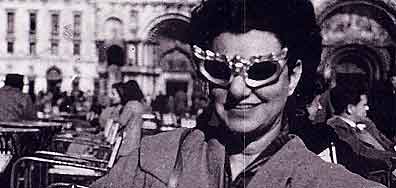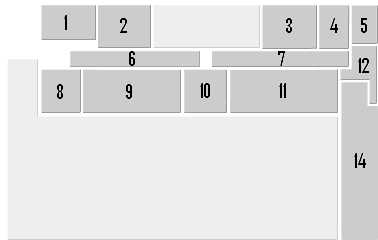Peggy Guggenheim Collection
 Peggy Guggenheim Collection | |
| Type | Modern Art |
|---|---|
| Location | Palazzo Venier dei Leoni, Dorsoduro 701, I-30123 Venezia |
| Phone | +39.041.2405.411 |
| Website | http://www.guggenheim-venice.it/inglese/default.html |
Located on the Grand Canal the Collezione Peggy Guggenheim contains notable works collected by Peggy Guggenheim, niece of the famous Solomon Guggenheim.
Peggy Guggenheim

Peggy grew up as any wealthy heiress did in the late 19th century to the early 20th century. Upon turning 38 Peggy made a shift from a “not particularly useful heiress” [1] to an important artistic figure of the 1900’s. In the 1930’s Guggenheim began purchasing non-commercial art thus marking the start to her large collection. In 1947 Peggy purchased the Palazzo Venier dei Leoni, and exhibited her collection at the Venice Biennale. After Peggy died the Palazzo Venier dei Leoni, became the home of the Peggy Guggenheim Collection at her request. Peggy often said that it was her duty to protect the art of her own time.
The Museum
The museum contains an adherence to a specific form of art. Unlike collectors today, who purchase for shear investment, Guggenheim was more of an art historian. She collected based on her interest with the intent of keeping the memory of 20th century culture alive.
The museum itself boasts works of various famous 20th century artists including Picasso, Magritte, Pollak, and Dali. The majority of the pieces contained cubist, abstract, and surrealist art forms.
Behind the museum overlooking the Canal, you will find The Angel of the City, a sculpture created by Marino Marini, which depicts a man mounted on a horse comparable to Andrea Verrocchio’s Bartolomeo Colleoni in Campo Santi Giovanni e Paolo. In order to enter the museum you must walk through the Nasher Sculpture Garden which contains various pieces of art and the burial site of Peggy Guggenheim. Each room is laid out retaining its original meaning when Peggy lived at the palace, but the artwork is organized room by room including a room dedicated solely to Jackson Pollock paintings and another to the paintings of Pegeen Vail. The museum has an entire wing dedicated to the collection of Gianni Mattioli who purchased many works of modern Italian artists.
Museum Map

- Drawing Room: Non - objective Russian and Dutch geometric abstraction. Includes pieces by Malevich, Pevsner, Mondrian and van Doesburg.
- Library: Contains her most famous surrealist paintings. Includes art by de Chirico, Ernst, and Tanguy.
- Guest Bedroom: Devoted entirely to Jackson Pollack.
- Peggy's Room: This room was left as it was upon Peggy's death.
- Small Room: Originally the master bathroom this room contains work done by Peegan Vail, Peggy's daughter from her marriage with Laurence Vail.
- West Corridor: Contains the avant-garde from 1900 to 1920 with works by Picasso and Gris and many others.
- East Corridor: More surrealist art of Ernst Tanguy and Brauner.
- Kitchen: The kitchen shows the evolution from cubism to Orphism and Futurism. The works of Delaunay and Kupka reresent the Orphism, and the works of Severini and Balla represent Futurism.
- Dining Room: Similar to Peggy's bedroom it is still furnished as it was in the 1940's.
- Entrance Hall: Again furnished as it was in the past displaying masterpieces by Picasso and a mobile by Calder.
- Large Room: Surrealist paintings representing Giacometti Ernst and Magritte among others.
- Dressing Room: Connects the Palazzo Venier dei Leoni with the Barchessa.
- Mattioli: This hall is based entirely on the works of the Giani Mattioli Collection.
See Also
| ||||||||||||||||||||